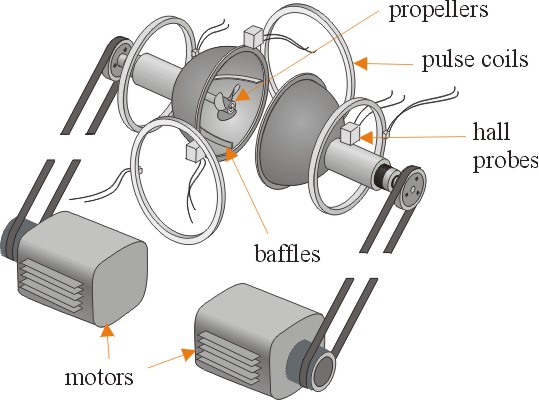Experiment

The liquid sodium is contained in a 30 cm diameter stainless steel sphere. The flow is driven by propellers mounted on coaxial shafts that enter through opposite ends of the sphere. The propellers are driven by two 7.5 kW electric motors at rotation rates from 10 to 120 Hz. Each motor's speed is independently controlled digitally. The temperature of the sodium is held within 5 degrees of 120 C with heaters and coolant tubing wrapped around the outside of the sphere.
We diagnose how close we are to dynamo action by applying external magnetic pulses to the sodium (100 G) and watching how fast the pulse decays. The slower the decay, the closer we are to a dynamo. For a given rotation rate of the propellers we observe fluctuating values of the decay rate. This leads us to predict the nature of the transition to dynamo will be intermittent. We have made quantifiable progress towards the transition, though we have not yet produced a flow that generates a dynamo.
Choosing a flow geometry advantageous to producing a dynamo is not a clear problem for unconstrained flows. We have tried many variations on the setup shown in the picture above: different propellers, poloidal and equatorial baffles, Cu plates and rings sandwiched between halves of the sphere.
We are also studying the system in the presence of a large DC externally applied magnetic field (2000 G). This field is strong enough that Lorentz forces suppress the turbulence and organize the flow. It is hoped that we may learn more about the dynamics and nature of the saturated field in these large field experiments.
MRI
You can now read the published PRL paper.
Diverse astrophysical phenomena involve the close interplay of rotation and magnetic fields. There is theoretical and computational evidence for the importance of small magnetic fields in destabilizing differential rotation: a process now often called the magnetorotational instability. This phenomena is invoked to explain how rotating clouds proceed to collapse in star formation. The instability leads to radial outflow of angular momentum, so that matter may fall inward instead of continuing to orbit. Magnetic fields in differentially rotating stars and planetary interiors are also thought to be affected. This research describes the first direct observation of this instability. The experimental device consists of liquid sodium confined between boundaries defined by a rotating inner sphere and a stationary outer sphere, with an imposed coaxial magnetic field. We characterize an array of observed patterns and dynamics in a saturated magnetorotational state and relate these observations to theoretical expectations.
- Measurements of the induced field allow us to produce detailed movies of the dynamics of the magnetorotational instability (here for a m=1 state).
- At higher appied field we see many different patterns, including m=0 states which remind one of the zonal flows on giant planets.
Publications
- B.E. Brawn, K. Joshi, D.P. Lathrop, N. Mujica and D.R. Sisan. Visualizing the invisible: Ultrasound velocimetry in liquid sodium. Chaos. 15 (4): 041104 (2005). [DOI] [ADS]
- D. Sisan, N. Mujica, W. Tillotson, Y-M. Huang, W. Dorland, A. Hassam, T. Antonsen and D. Lathrop. Experimental Observation and Characterization of the Magnetorotational Instability. Physical Review Letters. 93 (11) (2004). [DOI] [ADS] [arXiv]
- D.R Sisan, W.L Shew and D.P Lathrop. Lorentz force effects in magneto-turbulence. Physics of the Earth and Planetary Interiors. 135 (2-3): 137-159 (2003). [PDF] [DOI] [ADS]
- W.L. Shew, D.R. Sisan and D.P. Lathrop. Mechanically forced and thermally driven flows in liquid sodium. Magnetohydrodynamics. 38: 121-127 (2002). [ADS] [URL]
- D.P Lathrop, W.L Shew and D.R Sisan. Laboratory experiments on the transition to MHD dynamos. Plasma Physics and Controlled Fusion. 43 (12A): A151-A160 (2001). [DOI] [ADS]
- W.L. Shew, D.R. Sisan and D.P. Lathrop. Dynamo and Dynamics, a Mathematical Challenge. [URL]
- N. Peffley, A. Cawthorne and D. Lathrop. Toward a self-generating magnetic dynamo: The role of turbulence. Physical Review E. 61 (5): 5287-5294 (2000). [PDF] [DOI] [ADS]
